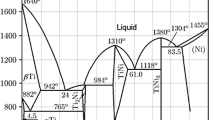Conclusions
In the hydrogen reduction of TiCl4, and thermal decomposition of Mo(CO)6 in a stream of shf discharge nitrogen plasma the main reaction products are titanium nitride and molybdenum. The impurity elements in the composite (carbon and oxygen) react with the titanium nitride, forming the titanium oxycarbonitride TiNxOyCz (where x + y + z = 1, y < 0.10, and z < 0.05). The formation of nitride particles takes place before the instant of full pyrolysis of Mo(C0)6, and molybdenum therefore does not cover them, but condenses in the form of free spherical particles whose mean size is about half that of the particles forming during the pyrolysis of the carbonyl without a TiCl4 addition to the reactor. A characteristic feature of the resultant fine molybdenum-nitride composite powders is a high uniformity of distribution of Ti and Mo in them.
Similar content being viewed by others
Literature cited
Mikio Hirogasi M., “The phase relationship and denitrification during the sintering process of TiN-Ni mixed powder compacts,” Trans. Jpn. Inst. Met.,21, No. 2 (1980).
O. Itaru, K. Hitokadzu, Y. Kuniharu, and Y. Minoru, “Sintered alloys of a golden color,” Jpn. Pat. No. 46-69298, Aug. 7, 1978.
I. Susumu, M. Yasuro, and T. Kadzi, “Sintered titanium-molybdenum alloy,” Jpn. Pat. No. 54-19846, Feb. 10, 1979.
O. Sedzi, “Method of manufacture of a hard metal for ornaments,” Jpn. Pat. No. 55-19974, Sept. 8, 1980.
R. Borg et al., “Method of making cermet powders,” U.S. Pat. No. 3892644, Mar. 12, 1975.
V. N. Troitskii, B. M. Grebtsov, I. A. Domashnev, and S. V. Gurov, “Synthesis of nitrides in shf discharge plasma,” in: Plasma-Chemical Reactions and Processes [in Russian], Nauka, Moscow (1977), pp. 26–49.
T. V. Rezchikova, V. N. Troitskii, N. V. Alekseev, and Yu. M. Shul'ga, “Dissociation of Mo(CO)6 in a stream of superhigh-frequency discharge nitrogen plasma,” Khim. Vys. Energ.,15, No. 2, 160–164 (1981).
V. N. Troitskii, “Some important aspects of the synthesis of nitrides in low-temperature plasma,” in: Synthesis in Low-Temperature Plasma [in Russian], Nauka, Moscow (1980), pp. 4–23.
I. A. Domashnev, O. D. Torbova, V. I. Berestenko, and V. N. Troitskii, “Superconductivity of small titanium oxynitride particles,” Fiz. Tverd. Tela,23, No. 10 (1981).
N. Pessal, R. Gold, and H. Johanson, “A study of superconductivity in interstitial compounds,” J. Phys. Chem. Solids,29, No. 1, 19–38 (1968).
V. I. Torbov, V. N. Troitskii, A. P. Zuev, et al., “State of oxygen in fine titanium nitride powders,” Poroshk. Metall., No. 9, 6–9 (1981).
Author information
Authors and Affiliations
Additional information
Translated from Poroshkovaya Metallurgiya, No. 11(251), pp. 3–8, November, 1983.
Rights and permissions
About this article
Cite this article
Rezchikova, T.V., Domashnev, I.A., Troitskii, V.N. et al. Production of very fine TiN-Mo composite powders in a low-temperature plasma stream. Powder Metall Met Ceram 22, 869–873 (1983). https://doi.org/10.1007/BF00805537
Received:
Issue Date:
DOI: https://doi.org/10.1007/BF00805537




